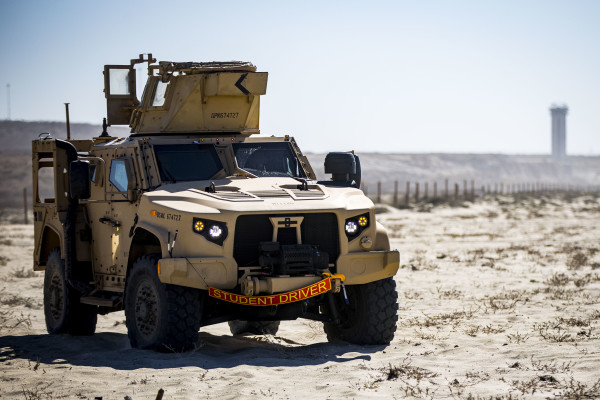

The Marine Corps plans on loading up its brand new battlewagons with a 30mm cannon to track and destroy enemy drones and aircraft, according to a new notice from the service.
A special award notice published last week announced that Marine Corps Systems Command intends to issue a sole-source, indefinite delivery/indefinite quantity contract to Northrup Grumman subcontractor Alliant Techsystems for up to 300 XM914E1 30 x 113mm chain guns, with the actual award scheduled for some time in fiscal year 2021.
The new chain guns are intended to provide the direct fire defeat capability required as part of the Marine Corps’ new Ground Based Air Defense (GBAD) Marine Air Defense Integrated Future Weapons System (MADIS/FWS), which would see the service affix a specialized weapons turret to the new Joint Light Tactical Vehicle to counter both drones and manned rotary and fixed-wing aircraft.
According to the special notice, the XM914E1 30mm handles multiple types of 30mm rounds, integrates seamlessly with the existing MADIS Mk1 weapons system, and “provides a readily available, non-developmental solution that can be integrated within the size, weight, and power parameters” of the JLTV Heavy Guns Carrier’s existing remote weapons station.

The Marine Corps has actively hunting for a 30mm cannon for the MADIS’s direct fire defeat requirement since at least April of this year, when the service issued a request for information for a system that could “mitigate the risk of attacks” from enemy drones and aircraft “while maintaining pace with maneuver forces.”
As Military.com notes, the service’s efforts to enhance the firepower capabilities of its next-generation JLTVs comes amid a military-wide effort, let by the Army, to update and modernize existing air defense capabilities amid preparations for a future conflict against near-peer allies like Russia and China.
Indeed, the Army has made efforts to aggressively up the firepower on its Stryker combat vehicles with a Maneuver Short-Range Air Defense (MSHORAD) system that doesn’t just include the XM813 30mm autocannon based on the Mk44 Bushmaster II from Northrop Grumman, but Hellfire and Stinger missiles alongside a M240 7.62mm machine gun as well.
The Marine Corps’ vMADIS Mk1 weapons system includes a turret-launched Stinger missile, multi-functional electronic warfare capability, a direct fire weapon (the XM914E1 chain gun, apparently), and “a shoulder-fired Stinger missile for dismounted operations,” according to MARCORSYSCOM.
The service’s new MADIS Mk2 system will focus more on countering drone threats with a 360-degree radar and command-and-control communications equipment in addition to a direct-fire remote weapons station and electronic warfare capabilities established in the Mk1 system.
Taken together, the two systems will work together seamlessly to enable the future Low-Altitude Air Defense (LAAD) battalions of Marine air wings “to counter UAV threat[s] efficiently, sustainably and organically with austere expeditionary forces,” according to the service.
Indeed, as Military.com previously noted, the service has already deployed a lighter variant of the MADIS (the LMADIS, naturally) affixed to an MRZR all-terrain vehicle to jam an Iranian drone that flew near the USS Boxer in the Strait of Hormuz back in July 2019.
Marines deployed to the U.S. Central Command area of responsibility around that time had deployed the LMADIS “to protect convoys or provide a forward operating base with protection from unmanned aerial systems,” as C4ISRNet reported last year, mostly against small drones weaponized by militants in the region.
Related: The Marine Corps wants to transform JLTVs into aircraft-killing trucks